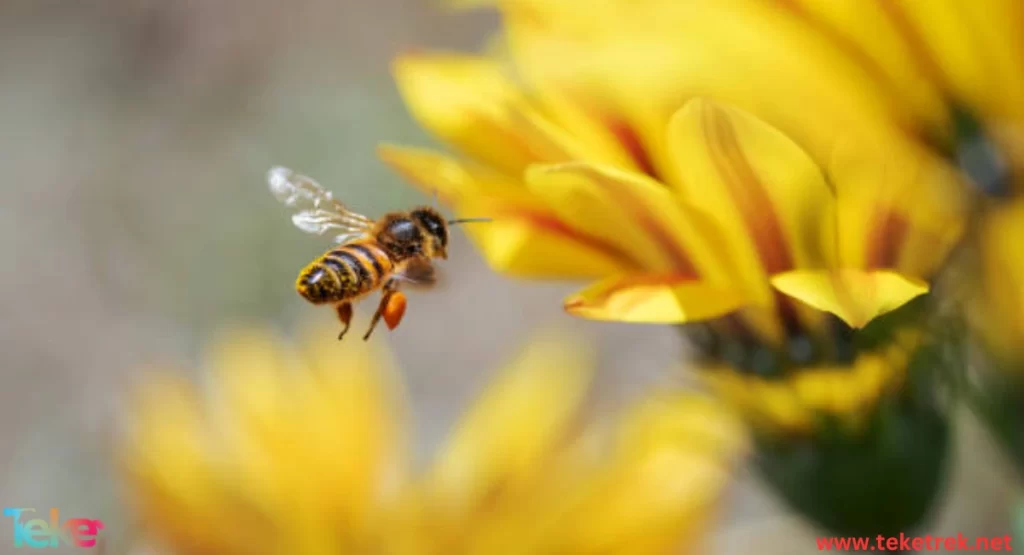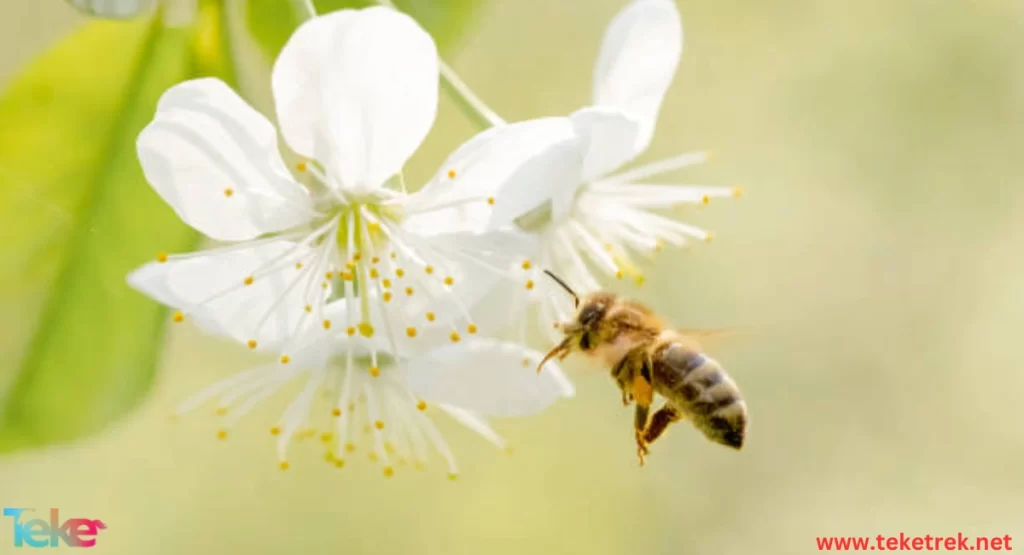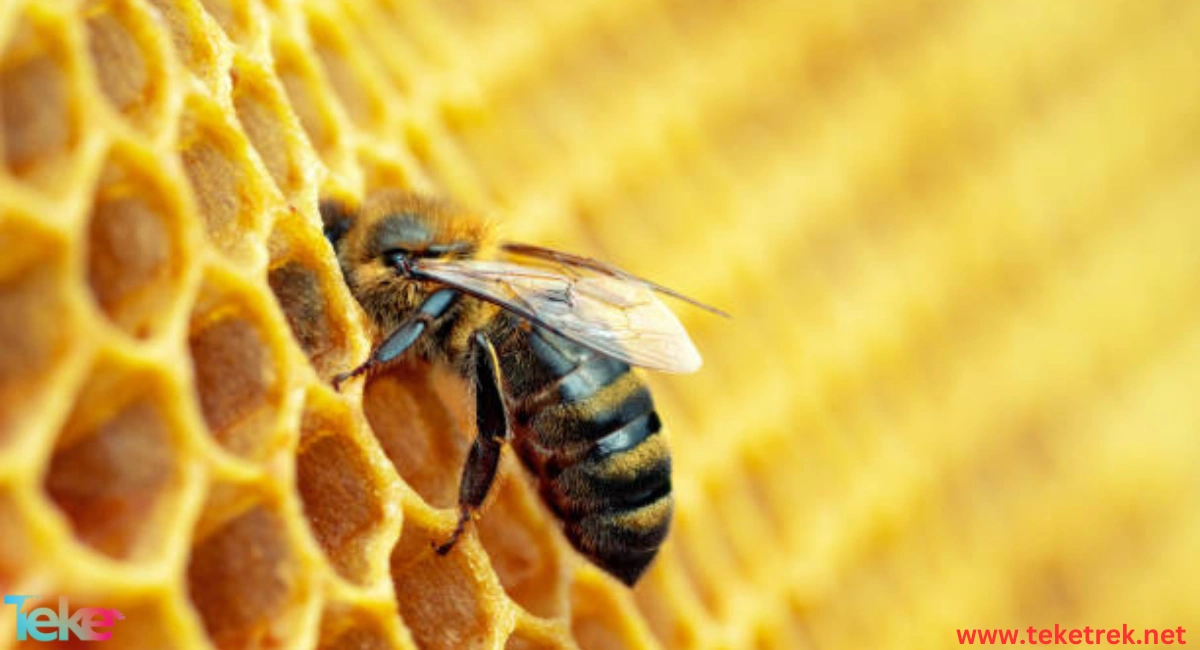In the heart of nature lives a small creature that carries within its tiny frame profound lessons in organization, communication, and adaptability.
The bee, this intricate being, is far more than just an insect that produces honey—it stands as a symbol of teamwork, natural intelligence, and ecological balance. Through its astonishing hive organization and its vital role in pollination and food security, the bee presents an inspiring model for executives and decision-makers seeking insights into successful leadership and sustainable practices.
In this article, we invite you on a deep journey into the world of bees—exploring how they learn, communicate, build, and adapt—while shedding light on their environmental importance and the powerful lessons we can draw from their way of life.
Let’s learn more about it from teketrek.
Facts about The Honey Bee
The honey bee belongs to the phylum Arthropoda, family Apidae.
The honey bee is the only insect that produces honey consumed by humans.
One of its main characteristics is its use of stinging mechanism against predators to protect the colony.
The honey produced by the honey bee contains all the necessary nutrients for life, including minerals, vitamins, and water.
The honey bee has 170 odor receptors.
Its sense of smell helps in recognizing relatives inside the bee cell and finding food by scent.
The honey bee has an extremely strong sense of smell.
Due to this sense, it can differentiate between hundreds of flower species and know if the flowers contain pollen or nectar.
The honey bee can flap its wings at an astonishing speed of around 200 beats per second, making it famous for its buzzing sound.
The honey bee can fly at speeds of up to 15 miles per hour.
A honey bee can collect approximately one kilogram of honey, flying around 90,000 miles.
During a nectar-collecting trip, a honey bee visits between 50 to 100 flowers.
A colony contains between 20,000 and 60,000 bees with one queen.
Worker honey bees are female and live for about 6 weeks in active seasons and 3 months in winter, performing all the work.

The Honey Bee Specification
The brain: It is oval in shape and the size of a sesame seed.
Despite this, it has an amazing ability to learn and remember things.
Eyes: The honey bee is characterized by having compound eyes, which require 50 wax scales to build in females and 120 wax scales in males.
Age, eggs: The queen bee can live up to 2 years and is the only bee that lays up to 2500 eggs per day.
Everything you need to know about bottlenose dolphins: intelligence, diet, behavior, and species
Types of Bees
There are many types of bees, some of which produce honey and some do not.
The most important types of honey-producing bees include:
- Giant Honey Bee (Apis dorsata): This bee lives in the wild on trees and rocks and is found in the Asian region. It builds a large-sized comb only.
- Dwarf Honey Bee (Apis florea): This bee is small in size and is not domesticated. It produces only one comb and lives in South Asia.
- Indian Honey Bees: This type of bee lives in India. It is larger than the dwarf bee and can be domesticated.
- Western Honey Bees: Named after its occurrence in the western Himalayas region. It is called universal because it is the only type that has spread worldwide.
Honey Bee Strains:
It divided into three groups:
African Strain:
In Africa, there are four strains, including:
- Moroccan Honey Bees: Small-sized bees inhabiting countries from Morocco to Libya in North Africa. It has few short hair, also characterized by its sharp nature.
- Egyptian Honey Bees: Small-sized bees with yellow color and shiny white hairs on their bodies. They are aggressive and do not tolerate cold, with low honey production.
- Cape Honeybees: This name is due to the presence of this breed in a narrow area on the southwest coast of the city of Cape Town in South Africa.
- African Honey Bees: Found in wide areas of Africa, from deserts to forests, stretching north from Senegal and Niger to Zambia in the south.
European breeds:
- Black Honey Bees: Also known as German bees, originating from Northern Europe, Western Alps, and Central Russia.
- Carniolan Honey Bee: This strain was the main reason for the spread of beekeeping in Egypt.
- Italian Honey Bees: Originating from Italy, these bees are somewhat small in size. They have relatively long tongues (6.3 – 6.6 mm). This strain has contributed to the spread and flourishing of beekeeping in the last hundred years.
Eastern Strains:
- Caucasian Honey Bees: Originating from highlands and valleys in the central Caucasus, similar in appearance and size to Carniolan bees. The color of the chitin is dark, and there are brown spots on the first stripes on the abdomen, the chest hairs in males are black, while in female workers they are grey.
- Anatolian Honey Bees: Native to Turkey, now bred there in mud cells, calm in temperament, large-sized with a dark yellow color.
- Armenian Honey Bee: Lives in Armenia, a yellow aggressive strain active in honey production.
- Cyprus Honey Bee: Resembles Italian bees but smaller in size, believed to be the origin of Syrian, Palestinian, and Italian strains, very active in honey collection.
- Yemeni Honey Bees: Found in East Africa, Sudan, Somalia, Chad, West Asia including Saudi Arabia, Yemen, and Oman.
- Syrian Honey Bees: Two varieties exist – fierce Siafi and obedient Ghanami. Difficult to distinguish externally, found in Syria and Lebanon.
- Palestinian Honey Bees: Known as Holy Land bees, historically significant, believed to be related to Egyptian bees.
Standard Strain:
Characterized by active queens laying eggs early in the season in large numbers.
What do honey bees eat?
Honey bees feed on grasses and flower nectar.
During winter, honey bees feed on the stored food they collected during the warmer months.
In winter, bees form a tight cluster in their hive to keep the queen and themselves warm.

How Do Honeybees Learn and Retain Information?
Despite their small size, bees possess remarkable learning abilities. They rely on what’s known as associative learning, linking specific stimuli (such as scents or colors) with rewards like nectar.
For instance, when a bee discovers a flower containing nectar, it stores this information and shares it with the hive. Studies show bees can retain information for days, which helps them become more efficient in nectar collection. This type of intelligence is quite similar to strategic decision-making in the workplace, where managers rely on data analysis and past experiences to achieve goals.
How Is a Beehive Managed? Lessons in Social Organization
The beehive is a model of perfect social organization. It consists of three main groups:
- The Queen: Responsible for laying eggs and maintaining the hive’s continuity.
- Worker Bees: Females who perform multiple tasks like nectar collection, cleaning, and guarding the hive.
- Drones: Their only role is to mate with the queen.
Every member knows its role precisely, ensuring smooth operation. This mirrors the structure of successful companies, where clearly defined roles and a shared goal lead to productivity. It highlights the importance of balancing specialization with collaboration to build effective teams.
How Do Bees Communicate? Explaining the “Waggle Dance”
Bees use a unique form of language known as the waggle dance to communicate inside the hive.
When a worker bee finds a nectar source, it returns and performs a precise dance that indicates:
- The direction of the source in relation to the sun.
- The distance between the hive and the source.
- The quality of nectar, based on the vigor of the dance.
This dance is not merely communication but a highly accurate information transmission system. Businesses can draw inspiration from this in improving internal communication, where clarity and speed are key to success.
Why Are Beehive Cells Hexagonal? The Scientific Explanation
The hexagonal shape of bee cells is an engineering marvel. It offers:
- Space Efficiency: Maximizes honey storage in limited space.
- Structural Strength: Provides solid support for the hive.
- Material Efficiency: Uses less wax than other shapes.
The scientific reasoning lies in the principle of minimum energy, where bees naturally select the most efficient design. This principle is applicable to resource management in companies—choosing solutions that yield the greatest results with the least cost.
How Does Pollination Work Between Bees and Plants?
Bees play a vital role in pollination, transferring pollen from male to female flower parts while collecting nectar.
This process helps plants reproduce and produce fruits and seeds. Crops like almonds, apples, and strawberries rely heavily on bees.
It represents an ideal environmental partnership—bees gain nectar, and plants benefit from pollination. This interaction reflects the value of strategic partnerships in business, where mutual cooperation leads to sustainable benefits.
Why Are Honeybees Crucial to Agriculture and Food Security?
Bees are essential to global food security. Estimates suggest they contribute to pollinating around 70% of global crops.
Without bees, the productivity of fruits, vegetables, and nuts would drastically decline, threatening food supplies.
In the U.S. alone, bees are responsible for over $15 billion annually in crop production.
This underscores the need to protect bees as part of sustainable environmental and economic strategies.
What Are the Benefits of Bee Venom? From Defense to Therapy
Bee venom, or apitoxin, serves as the hive’s defense mechanism but also has therapeutic applications, such as:
- Treating Arthritis: Used in alternative medicine for pain and inflammation.
- Skin Care: Included in cosmetics to reduce wrinkles.
- Immune Boosting: Stimulates immune responses in some cases.
However, it must be used with caution due to possible allergic reactions.
This versatility highlights how challenges can be turned into opportunities—applicable to business scenarios as well.
How Do Bees Navigate and Return to Their Hive?
Bees use a complex navigation system based on:
- The Sun: A primary reference point for direction.
- Visual Memory: Recognizing landmarks to find their way.
- Magnetic Fields: Assists navigation on cloudy days.
This ability emphasizes the importance of direction and planning in project management, where leaders need clear tools to guide efforts and stay aligned with goals.
What Are the Main Threats Facing Honeybees Today?
Bees are under threat from several sources:
- Pesticides: Damage their nervous systems.
- Climate Change: Disrupts blooming seasons and nectar availability.
- Diseases and Parasites: Like the Varroa mite, which weakens hives.
- Habitat Loss: Due to urbanization and intensive farming.
These risks highlight the need for protective measures such as reducing pesticide use and promoting sustainable agriculture.
How Are Bees Used as Indicators of Environmental Health?
Bees are sensitive environmental indicators. A drop in their population or changes in behavior can point to:
- Air or water pollution.
- Lack of natural resources like flowers.
- Climate changes.
Companies can adopt this approach by monitoring “performance indicators” to assess workplace health and make proactive decisions.
How Do Bees Adapt to Weather Changes?
Bees adapt through:
- Temperature Regulation: Vibrating to generate heat inside the hive.
- Food Storage: Collecting honey reserves for winter.
- Activity Reduction: Limiting flights in cold weather.
This adaptation illustrates the value of resilience—a vital skill for leaders facing rapidly changing business environments.
What Is the Origin of Honeybees? A Glimpse Into Their Evolution
Honeybees evolved from wasps around 100 million years ago.
While wasps were predators, bees adapted to a vegetarian diet, relying on nectar and pollen.
This evolution demonstrates how species can adapt to new environments—a lesson in product and service innovation to meet market needs.
What Does a Worker Bee Do Throughout the Day?
Worker bees are highly industrious. Their duties include:
- Collecting nectar and pollen.
- Cleaning the hive and removing waste.
- Feeding larvae and the queen.
- Building wax cells.
This diversity of roles showcases the importance of multi-skilled individuals in modern work environments.
Can Bee Breeds Be Crossbred? Benefits and Risks
Crossbreeding bee strains aims to improve productivity and disease resistance.
Benefits: More honey and better adaptability.
Risks: Loss of genetic diversity and higher disease susceptibility.
This reflects innovation challenges in business—balancing benefits with potential risks.
What Happens Inside the Hive at Night? Bee Activity in Darkness
At night, bee activity slows but doesn’t stop. Bees:
- Regulate hive temperature.
- Repair damaged cells.
- Guard the hive from threats.
This illustrates the importance of behind-the-scenes operations in ensuring systems continue running—just like backend processes in business operations.
FAQs about the honey bee
What is the history of the honey bee?
The origins of honeybees
It is thought that bees originally evolved from hunting wasps which acquired a taste for nectar and decided to become vegetarians. Fossil evidence is sparse but bees probably appeared on the planet about the same time as flowering plants in the Cretaceous period, 146 to 74 million years ago.
Why is it called a honey bee?
The genus name Apis is Latin for “bee”, and mellifera is the Latin for “honey-bearing” or “honey carrying”, referring to the species’ production of honey.
What is another name for honey bee?
The best-known honey bee is the western honey bee, (Apis mellifera), which was domesticated for honey production and crop pollination. The only other domesticated bee is the eastern honey bee (Apis cerana), which occurs in South, Southeast, and East Asia.
What do honey bees do?
Honeybees pollinate $15 billion worth of crops in the United States each year, including more than 130 types of fruits, nuts, and vegetables. Honeybees also produce honey, worth about $3.2 million in 2017 according to USDA-National Agricultural Statistics Service (NASS).
How do honey bees communicate?
Honeybees have evolved an extraordinary form of communication known as the “waggle” dance. It is highly symbolic, separated as it is in both time and space from the activity it …grew out of (discovering a nectar source) and the activity it will spur on (getting other bees to go to that nectar source).
Which country is famous for honey bees?
India has the largest number of beehives, totaling around 12.6 million, followed by China with about 9.4 million.
In conclusion, Bees are not just insects, but masters of organization, communication, and adaptation. By studying their behavior, executives and decision-makers can draw valuable lessons for managing teams, improving efficiency, and maintaining sustainability. With bees facing increasing environmental challenges, it is our duty to protect them as part of our commitment to the environment and food security. We invite you to take action, whether by supporting sustainable agriculture or raising awareness about the importance of bees, to ensure that these amazing creatures continue to inspire and support our lives.
They are essential to human life and we hope that this article has provided you with valuable information and amazing facts to help you learn more about honey bees.
References:





